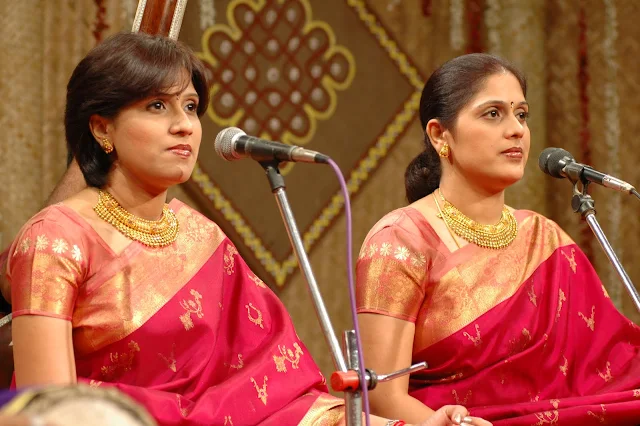Shanmukhapriya and Haripriya ( Telugu: షణ్ముఖప్రియ, హరిప్రియ Tamil: ஷண்முக ப்ரியா, ஹரிப்ரியா ), popularly known as the Priya Sisters, are eminent Carnatic music singers.
They hail originally from Amalapuram in East Godavari District, Andhra Pradesh.They started learning Carnatic music from their father, Sri V.V.Subbaram, at an early age. In order to nurture their musical talent, their father shifted base to Chennai. Later they became the disciples of the renowned duo Radha and Jayalakshmi who were disciples of the legendary G. N. Balasubramaniam. They learnt many nuances and subtleties of music during the five-year tenure under them including the advice that the singing should be so clear that the listener should be able to notate the entire kriti.
Improving their repertoire was a major project and learning, a continuous process. Hence they joined Professor T.R.Subramaniam. They learnt many pallavis and kritis from him.
They are part of the trend of duo singing in Carnatic music, which started in the 1950s, with performers like Radha Jayalakshmi, Soolamangalam Sisters and later continued by Bombay Sisters.
They hail originally from Amalapuram in East Godavari District, Andhra Pradesh.They started learning Carnatic music from their father, Sri V.V.Subbaram, at an early age. In order to nurture their musical talent, their father shifted base to Chennai. Later they became the disciples of the renowned duo Radha and Jayalakshmi who were disciples of the legendary G. N. Balasubramaniam. They learnt many nuances and subtleties of music during the five-year tenure under them including the advice that the singing should be so clear that the listener should be able to notate the entire kriti.
Improving their repertoire was a major project and learning, a continuous process. Hence they joined Professor T.R.Subramaniam. They learnt many pallavis and kritis from him.
They are part of the trend of duo singing in Carnatic music, which started in the 1950s, with performers like Radha Jayalakshmi, Soolamangalam Sisters and later continued by Bombay Sisters.






